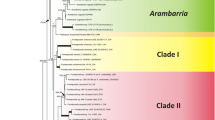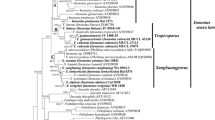Abstract
Taxonomic and phylogenetic studies of the Funalia gallica species complex and its related species were carried out. The phylogenetic analyses were based on datasets of either combined ITS, nrLSU and RPB2 sequences or single ITS sequences. The results reveal that at least four strongly hispid to strigose Funalia species can be recognised, i.e. the cosmopolitan F. trogii, Eurasian F. gallica, North American “F. gallica” and a new species F. subgallica discovered from tropical China. Morphologically, F. subgallica is characterised by its strongly hispid to strigose pileal surface, large pores (1–3 per mm) and basidiospores (11–15 × 4–5 μm).




Similar content being viewed by others
References
Bondartsev A, Singer R (1941) Zur Systematik der Polyporaceae. Annales Mycologici 39(1):43–65
Chen JJ, Cui BK, Dai YC (2016) Global diversity and molecular systematics of Wrightoporia sl (Russulales, Basidiomycota). Persoonia 37:21–36. doi:10.3767/003158516X689666
Chenna R, Sugawara H, Koike T, Lopez R, Gibson TJ, Higgins DG, Thompson JD (2003) Multiple sequence alignment with the Clustal series of programs. Nucleic Acids Res 31:3497–3500. doi:10.1093/nar/gkg500
Daâssi D, Rodríguez-Couto S, Nasri M, Mechichi T (2014) Biodegradation of textile dyes by immobilized laccase from Coriolopsis gallica into Ca-alginate beads. Int Biodeter Biodegr 90:71–78. doi:10.1016/j.ibiod.2014.02.006
Dai YC (2012) Polypore diversity in China with an annotated checklist of Chinese polypores. Mycoscience 53:49–80. doi:10.1007/s10267-011-0134-3
Dai YC, Yuan HS (2010) Type studies on polypores described by JD Zhao. Ann Bot Fenn 47(2):113–117
Dai YC, Cui BK, Yuan HS, Li BD (2007) Pathogenic wood-decaying fungi in China. For Pathol 37:105–120
Dai YC, Cui BK, Liu XY (2010) Bondarzewia podocarpi, a new and remarkable polypore from tropical China. Mycologia 102:881–886. doi:10.3852/09-050
Farris JS, Källersjö M, Kluge AG, Bult C (1994) Testing significance of incongruence. Cladistics 10:315–319
Felsenstein J (1985) Confidence limits on phylogenies: an approach using the bootstrap. Evolution 39:783–791. doi:10.2307/2408678
Gilbertson RL, Ryvarden L (1986) North American polypores, vol. 1. Fungiflora, Oslo
Hall TA (1999) BioEdit: a user-friendly biological sequence alignment editor and analysis program for Windows 95/98/NT. Nucleic Acids Symp Ser 41:95–98
Jia BS, Zhou LW, Cui BK, Rivoire B, Dai YC (2014) Taxonomy and phylogeny of Ceriporia (Polyporales, Basidiomycota) with an emphasis of Chinese collections. Mycol Prog 13:81–93. doi:10.1007/s11557-013-0895-5
Justo A, Hibbett DS (2011) Phylogenetic classification of Trametes (Basidiomycota, Polyporales) based on a five-marker dataset. Taxon 60:1567–1583
Li HJ (2013) Taxonomy and phylogeny of Trametes and related genera in China. PhD thesis, Beijing Forestry University, Beijing (in Chinese)
Li HJ, Cui BK, Dai YC (2014a) Taxonomy and multi-gene phylogeny of Datronia (Polyporales, Basidiomycota). Persoonia 32:170–182. doi:10.3767/003158514X681828
Li HJ, Li XC, Vlasák J, Dai YC (2014b) Neofomitella polyzonata gen. et sp. nov., and N. fumosipora and N. rhodophaea transferred from Fomitella. Mycotaxon 129:7–20. doi:10.5248/129.7
Matheny PB (2005) Improving phylogenetic inference of mushrooms with RPB1 and RPB2 nucleotide sequences (Inocybe; Agaricales). Mol Phylogenet Evol 35:1–20
Murrill WA (1905) The Polyporaceae of North America 11. A synopsis of the brown pileate species. Bull Torrey Bot Club 32(7):353–371
Niemelä T, Kotiranta H, Penttilä R (1992) New records of rare and threatened polypores in Finland. Karstenia 32:81–94
Núñez M, Ryvarden L (2001) East Asian polypores 2. Polyporaceae s. lato. Syn Fung 14:170–522
Nylander JAA (2004) MrModeltest 2.2. Program distributed by the author. Evolutionary Biology Centre, Uppsala University, Uppsala
Page RDM (1996) Treeview: An application to display phylogenetic trees on personal computers. Comput Appl Biosci 12:357–358
Patouillard N (1900) Essai taxonomique sur les familles et les genres des Hyménomycètes. Lucien Declume, Lons-Le-Saunier, pp 1–184
Petersen JH (1996) Farvekort. The Danish Mycological Society’s color-chart. Foreningen til Svampekundskabens Fremme, Greve
Posada D, Crandall KA (2001) Selecting the best-fit model of nucleotide substitution. Syst Biol 50:580–601. doi:10.1080/106351501750435121
Ronquist F, Huelsenbeck JP (2003) MrBayes 3: Bayesian phylogenetic inference under mixed models. Bioinformatics 19:1572–1574
Ryvarden L, Gilbertson RL (1993) European polypores. Syn Fung 6:1–387
Song J, Han ML, Cui BK (2015) Fistulina subhepatica sp. nov. from China inferred from morphological and sequence analyses. Mycotaxon 130:47–56. doi:10.5248/130.47
Swofford DL (2002) PAUP: Phylogenetic analysis using parsimony, Version 4.0b10. Sinauer Associates, Inc. Publishers, Sunderland
Tian XM, Yu HY, Zhou LW, Decock C, Vlasák J, Dai YC (2013) Phylogeny and taxonomy of the Inonotus linteus complex. Fungal Divers 58:159–169. doi:10.1007/s13225-012-0202-9
White TJ, Bruns TD, Lee SB, Taylor JW (1990) Amplification and direct sequencing of fungal ribosomal RNA genes for phylogenetics. In: Innis MA, Gelfand DH, Sninsky JJ, White TJ (eds) PCR protocols: a guide to methods and applications. Academic Press, San Diego, pp 315–322
Zhao JD, Zhang XQ (1991) Four new species of Polyporaceae in China. Acta Mycol Sin 10:266–272
Zmitrovich IV, Malysheva VF (2013) Towards a phylogeny of Trametes alliance (Basidiomycota, Polyporales). Mikol Fitopatol 47(6):358–380
Acknowledgements
Special thanks are due to Prof. Bao-Kai Cui (Beijing Forestry University, China) for the assistance on field trips. We express our gratitude to Prof. Yu-Cheng Dai (Beijing Forestry University, China) and the two anonymous reviewers for improving the manuscript. The research is financed by the National Natural Science Foundation of China (no. 31470144).
Author information
Authors and Affiliations
Corresponding author
Rights and permissions
About this article
Cite this article
Li, HJ., Si, J., Zhang, YZ. et al. Taxonomic and phylogenetic studies reveal a new species from Funalia gallica complex (Polyporales, Basidiomycota). Mycol Progress 15, 23 (2016). https://doi.org/10.1007/s11557-016-1167-y
Received:
Revised:
Accepted:
Published:
DOI: https://doi.org/10.1007/s11557-016-1167-y




